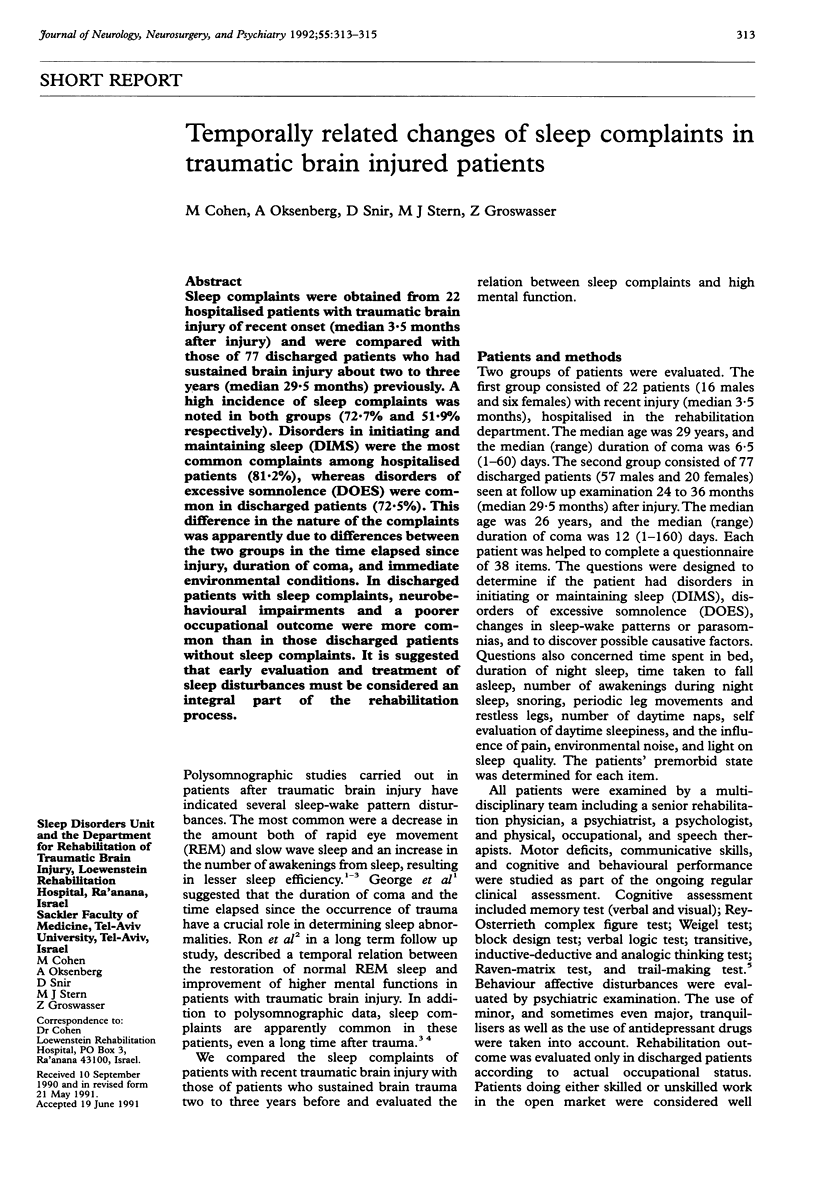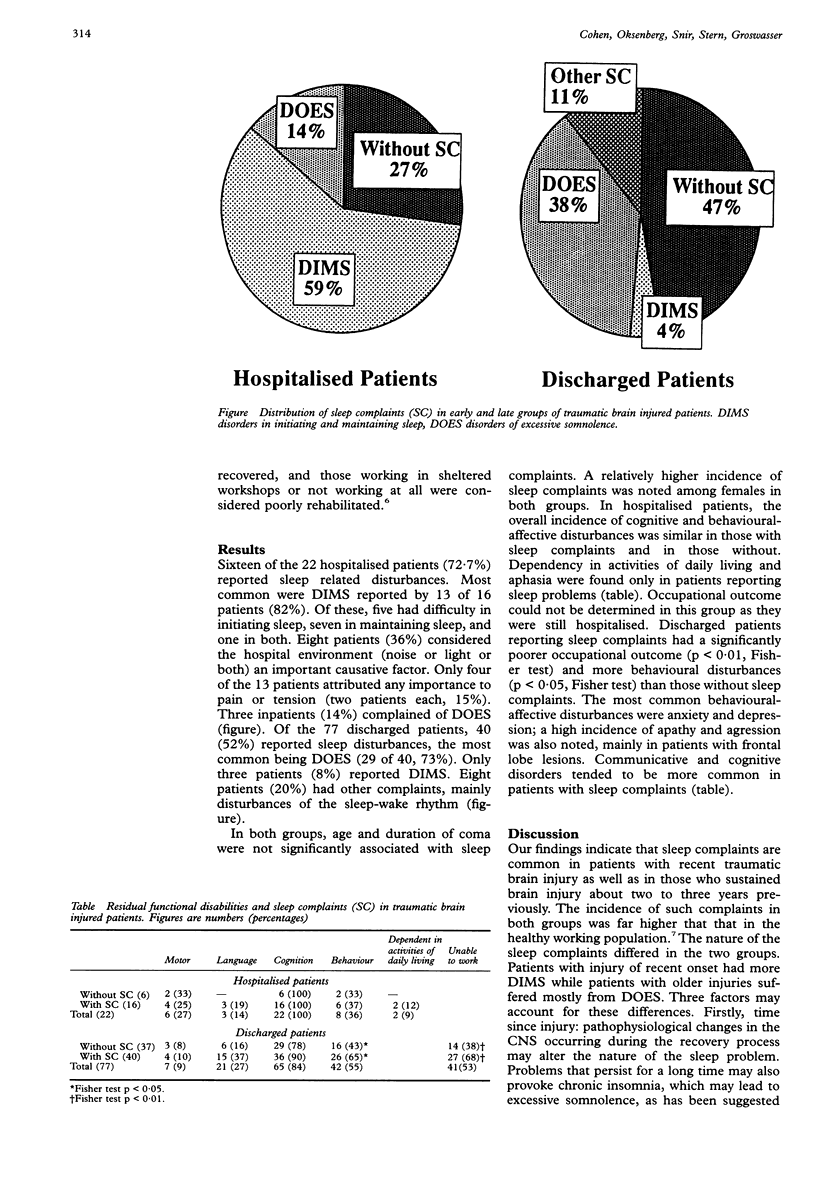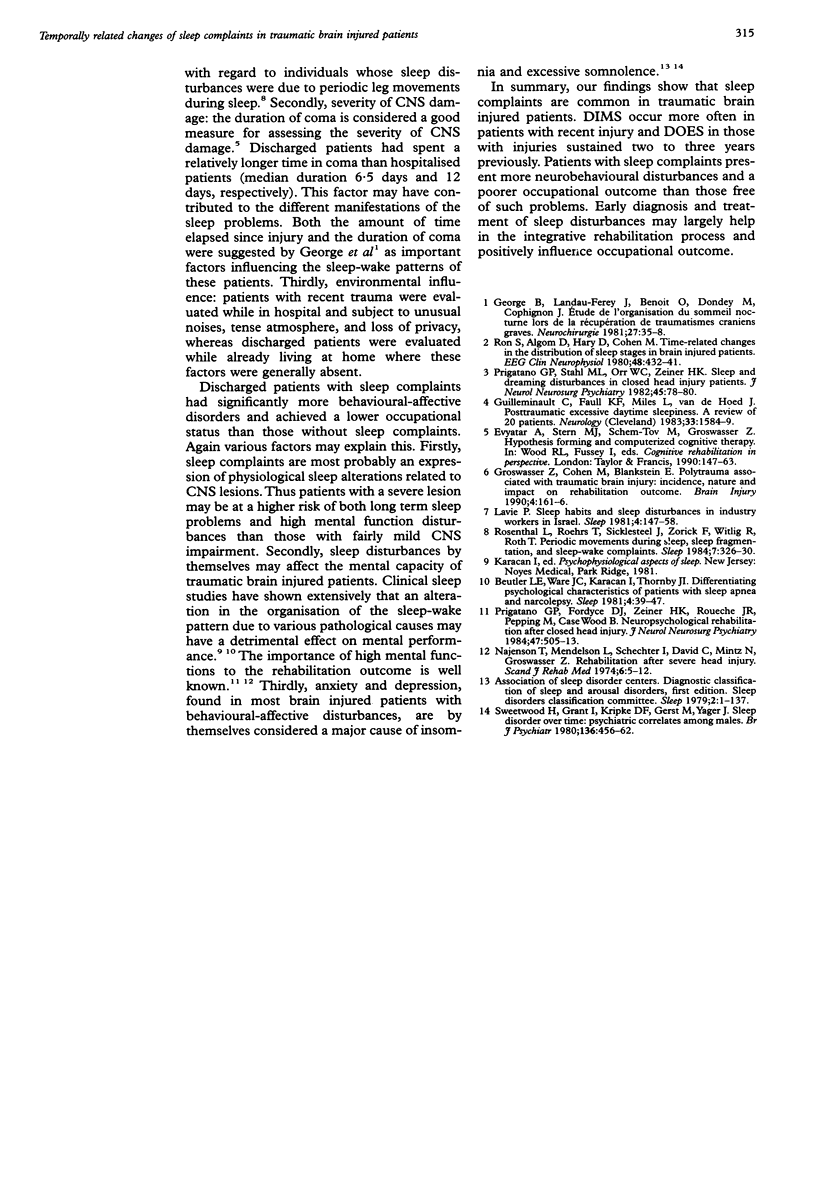Abstract
Sleep complaints were obtained from 22 hospitalised patients with traumatic brain injury of recent onset (median 3.5 months after injury) and were compared with those of 77 discharged patients who had sustained brain injury about two to three years (median 29.5 months) previously. A high incidence of sleep complaints was noted in both groups (72.7% and 51.9% respectively). Disorders in initiating and maintaining sleep (DIMS) were the most common complaints among hospitalised patients (81.2%), whereas disorders of excessive somnolence (DOES) were common in discharged patients (72.5%). This difference in the nature of the complaints was apparently due to differences between the two groups in the time elapsed since injury, duration of coma, and immediate environmental conditions. In discharged patients with sleep complaints, neurobehavioural impairments and a poorer occupational outcome were more common than in those discharged patients without sleep complaints. It is suggested that early evaluation and treatment of sleep disturbances must be considered an integral part of the rehabilitation process.
Full text
PDF


Selected References
These references are in PubMed. This may not be the complete list of references from this article.
- Beutler L. E., Ware J. C., Karacan I., Thornby J. I. Differentiating psychological characteristics of patients with sleep apnea and narcolepsy. Sleep. 1981;4(1):39–47. doi: 10.1093/sleep/4.1.39. [DOI] [PubMed] [Google Scholar]
- George B., Landau-Ferey J., Benoit O., Dondey M., Cophignon J. Etude de l'organisation du sommeil nocturne lors de la récupération de traumatismes crâniens graves. Neurochirurgie. 1981;27(1):35–38. [PubMed] [Google Scholar]
- Groswasser Z., Cohen M., Blankstein E. Polytrauma associated with traumatic brain injury: incidence, nature and impact on rehabilitation outcome. Brain Inj. 1990 Apr-Jun;4(2):161–166. doi: 10.3109/02699059009026161. [DOI] [PubMed] [Google Scholar]
- Guilleminault C., Faull K. F., Miles L., van den Hoed J. Posttraumatic excessive daytime sleepiness: a review of 20 patients. Neurology. 1983 Dec;33(12):1584–1589. doi: 10.1212/wnl.33.12.1584. [DOI] [PubMed] [Google Scholar]
- Lavie P. Sleep habits and sleep disturbances in industrial workers in Israel: main findings and some characteristics of workers complaining of excessive daytime sleepiness. Sleep. 1981;4(2):147–158. doi: 10.1093/sleep/4.2.147. [DOI] [PubMed] [Google Scholar]
- Najenson T., Mendelson L., Schechter I., David C., Mintz N., Groswasser Z. Rehabilitation after severe head injury. Scand J Rehabil Med. 1974;6(1):5–14. [PubMed] [Google Scholar]
- Prigatano G. P., Fordyce D. J., Zeiner H. K., Roueche J. R., Pepping M., Wood B. C. Neuropsychological rehabilitation after closed head injury in young adults. J Neurol Neurosurg Psychiatry. 1984 May;47(5):505–513. doi: 10.1136/jnnp.47.5.505. [DOI] [PMC free article] [PubMed] [Google Scholar]
- Prigatano G. P., Stahl M. L., Orr W. C., Zeiner H. K. Sleep and dreaming disturbances in closed head injury patients. J Neurol Neurosurg Psychiatry. 1982 Jan;45(1):78–80. doi: 10.1136/jnnp.45.1.78. [DOI] [PMC free article] [PubMed] [Google Scholar]
- Ron S., Algom D., Hary D., Cohen M. Time-related changes in the distribution of sleep stages in brain injured patients. Electroencephalogr Clin Neurophysiol. 1980 Apr;48(4):432–441. doi: 10.1016/0013-4694(80)90135-2. [DOI] [PubMed] [Google Scholar]
- Rosenthal L., Roehrs T., Sicklesteel J., Zorick F., Wittig R., Roth T. Periodic movements during sleep, sleep fragmentation, and sleep-wake complaints. Sleep. 1984;7(4):326–330. doi: 10.1093/sleep/7.4.326. [DOI] [PubMed] [Google Scholar]
- Sweetwood H., Grant I., Kripke D. F., Gerst M. S., Yager J. Sleep disorder over time: psychiatric correlates among males. Br J Psychiatry. 1980 May;136:456–462. doi: 10.1192/bjp.136.5.456. [DOI] [PubMed] [Google Scholar]


